Related Research Articles

Abraham Washington Attell, often referred to by newspapers as "The Little Hebrew", was an American boxer who became known for his record-setting, six year consecutive reign as World Featherweight Champion from 1906 to 1912, and his nearly consecutive ten-year reign starting in 1902. Said to be a friend of the gangster Arnold Rothstein, Attell was charged with game fixing in the Black Sox Scandal in 1919, but the charges were dismissed before trial. He also was suspected of other infractions including fixing fights, and using drugs during a fight.
1903 in sports describes the year's events in world sport.

Primo Carnera, nicknamed the Ambling Alp, was an Italian professional boxer and wrestler who reigned as the boxing World Heavyweight Champion from 29 June 1933 to 14 June 1934. He won more fights by knockout than any other heavyweight champion in boxing history.
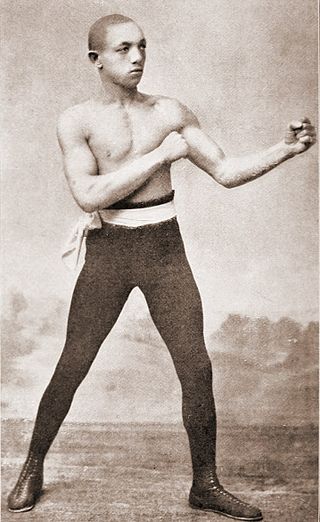
George Dixon was a Canadian professional boxer. After winning the bantamweight title in 1890, he became the first ever black athlete to win a world championship in any sport; he was also the first Canadian-born boxing champion. Ring Magazine founder Nat Fleischer ranked Dixon as the #1 featherweight of all-time. He was inducted into Canada's Sports Hall of Fame in 1955, the Ring Magazine Hall of Fame in 1956 and the International Boxing Hall of Fame as a first-class inductee in 1990. In 2018 he was named one of the greatest 15 athletes in Nova Scotia's history, ranking sixth.

James John Corbett was an American professional boxer and a World Heavyweight Champion, best known as the only man who ever defeated John L. Sullivan. Despite a career spanning only 20 bouts, Corbett faced the best competition his era had to offer, squaring off with a total of nine fighters who would later be enshrined alongside him in the International Boxing Hall of Fame.
Monte Attell, born in the Knob Hill neighborhood of San Francisco, California, United States, was an American boxer.

The Olympic Club is an athletic club and private social club in San Francisco, California.
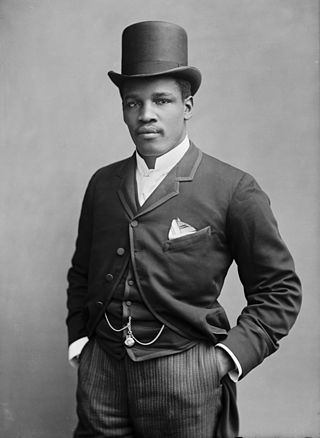
Peter Jackson was an Australian heavyweight boxer who had a significant international career. Jackson was inducted into the International Boxing Hall of Fame in the inaugural 1990 class, as well as being the 2004 inductee for the Australian National Boxing Hall of Fame in the Pioneers category.

Featherweight Joe Bernstein was one of the first great boxers to emerge from New York's Lower East Side. He fought for the featherweight championship three times, but lost all three bouts, often in close matches. Nicknamed "The Pride of the Ghetto" in the 1890s, his championship fights endeared him to newly arriving Jewish immigrants.

Harry Harris was an American boxer. He was the World Bantamweight champion from 1901 to 1902, but boxed top-rated opponents throughout his career. Charley Rose ranked Harris as the #10 All-Time Bantamweight.
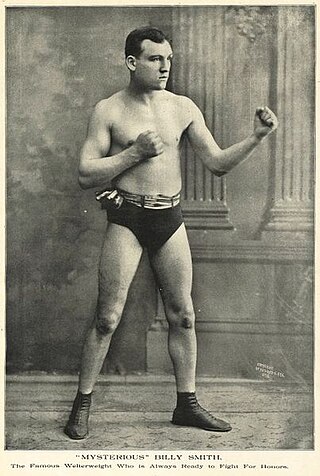
William Amos Smith(Aka "Mysterious Billy" Smith) was a Canadian born two-time world welterweight boxing champion of the world: first at age 21 in 1892, then again in 1898 at the age of 27. He became famous world-wide for his boxing success and also became infamous for his associations and involvement with criminal activities in Portland, Oregon, in the early 1900s. He was later described as the "Dirtiest fighter of all Time". Smith died at the age of 66 on October 15, 1937, and was buried at Multnomah Park Cemetery in Portland Oregon.
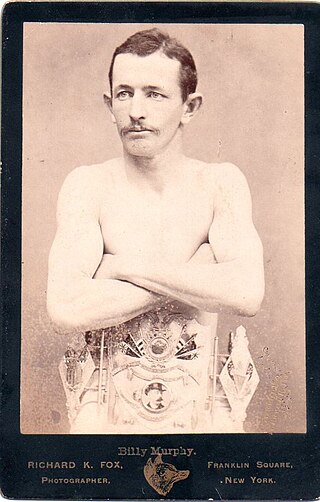
Thomas William Murphy was a New Zealand boxer. An early World Featherweight Champion, he was the first world champion of any weightclass to come from New Zealand. In his early career, he took the New Zealand Lightweight Championship.

Frankie Burns was a top rated American bantamweight boxer from New Jersey who contended four times for the World Bantamweight Championship between 1912 and 1917, twice meeting Johnny Coulon. Founder of Ring Magazine, Nat Fleischer ranked Burns as the #8 All-Time Bantamweight.
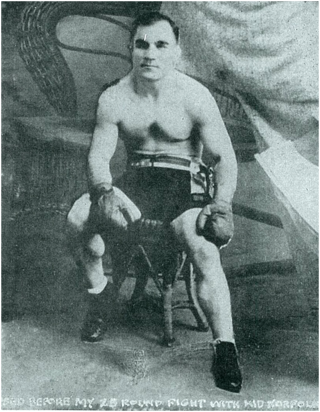
Abe "The Newsboy" Hollandersky was an American professional boxer who won the Panamanian national Heavyweight Title when he defeated Californian Jack Ortega in nine rounds in Panama City on May 30, 1913. American congressmen, Naval personnel, and canal workers were among the crowd of nearly two thousand who watched Hollandersky gain victory over an opponent who outweighed him by over thirty-five pounds. The New York Times announced Hollandersky's best known win the following morning.

Austin Rice was a New London boxer who became a Featherweight Title contender on January 14, 1903, when he faced featherweight champion Young Corbett II in Hot Springs, Arkansas. Though he lost the fight, he went toe to toe with a world class competitor for eighteen rounds and would meet four more boxing champions, easily placing him among the World's top ten featherweight boxers for his era.

"Buffalo" Eddie Kelly was an American boxer who contended three times for the Featherweight Championship of the World against reigning champion Abe Attell between February 1908 and February 1909. Attell was Featherweight Champion for a record eleven years, between 1901 and 1912, and fought Kelly three more times in non-title fights. Kelly's three attempts at the Featherweight Championship were a record at the time for the three-year period, and it placed him squarely in the top five of rated Featherweights for those years.

Frankie Neil was a World Bantamweight champion. Fighting at 114 1/2 pounds, he took the world title from reigning champion Harry Forbes on August 13, 1903, at the Mechanics Pavilion in San Francisco in a second-round knockout of a match scheduled for twenty rounds. Eddie Graney was the referee. Neil held the title only a little over a year, losing it on October 17, 1904, to British boxing champion Joe Bowker.

Harry Forbes was an American boxer who took the World Bantamweight Title on November 11, 1901, when he defeated Danny Dougherty in a second-round knockout in Saint Louis, Missouri. He lost the title three years later, on August 13, 1903, to Frankie Neil in a second-round knockout at the Mechanics Pavilion in San Francisco, California.

Jimmy Walsh was an American boxer who claimed the World Bantamweight Championship on March 29, 1905, when he defeated Monte Attell, in a controversial six-round bout at the National Athletic Club in Philadelphia. His claim was recognized by the World Boxing Association, at the time the National Boxing Association. The fight ended in a disqualification called by the referee when Walsh sent a low right hook that landed below the belt of Attell. Most sources believed Walsh had led throughout the fight and that the blow should have been considered legal, which may be why Walsh was credited with the title by the National Boxing Association.
Jimmy Reagan (1888-1975) was an American boxer who claimed the World Bantamweight Championship in a twelve-round bout on January 29, 1909 against Jimmy Walsh at Dreamland Rink in San Francisco, California. He lost the title only a month later in an historic twenty round bout on February 22, 1909 to Monte Attell at the Mission Street Arena in San Francisco. Reagan's primary manager was Jack Davis. During his career he fought Battling Nelson, Peanuts Sinclair, future lightweight champion Willie Ritchie, World Feather and Lightweight contender "Mexican Joe" Rivers and reigning lightweight champion Benny Leonard.
References
- 1 2 3 4 5 Somrack, F. Daniel (2005). Boxing in San Francisco. Images of America. Charleston, South Carolina: Arcadia Publishing. pp. 7, 73. ISBN 9780738528861 . Retrieved January 13, 2013.
- 1 2 3 4 5 6 7 Barry, Richard (March 1913). "Abe Attell, The Elusive Feather". Pearson's Magazine. 29 (3). New York: The Pearson Publishing Co.: 353–359. Retrieved January 13, 2013.
- 1 2 Petersen, Bob (2011). "Offensive Tour, 1888-1889". Peter Jackson: A Biography of the Australian Heavyweight Champion, 1860-1901. Jefferson, North Carolina: McFarland & Company, Inc. p. 58. ISBN 9780786458813 . Retrieved January 13, 2013.
- ↑ San Francisco Italian Athletic Club
- ↑ "40 Years steeped in tradition and pride | lofrano". Archived from the original on 2014-09-17. Retrieved 2014-09-17.